
Venus is often described as the twin of Earth, as it has a diameter and mass very close to those of our planet. However, behind this apparent similarity lies an atmospheric and geological hell. Its thick layer of CO₂ and clouds of H₂SO₄ cause an uncontrolled greenhouse effect, raising the average temperature to nearly 465 °C.
Venus's atmosphere is composed of more than 96% carbon dioxide, with a surface pressure about 92 times that of Earth, equivalent to diving 900 meters under the ocean. Under these conditions, even metals like lead melt on the surface. The Soviet Venera missions were the first to transmit images from this scorching ground before succumbing within tens of minutes to the heat and pressure.
Unlike most planets, Venus rotates in the opposite direction to its revolution around the Sun, a phenomenon known as retrograde rotation. Its sidereal day lasts 243 Earth days, longer than its Venusian year of 225 days. This slow rotation and the absence of an intrinsic magnetic field provide little protection from solar winds, accelerating the gradual loss of its lighter gases.
Radar data, particularly from the Magellan mission (1989-1994), revealed that Venus's surface is dotted with vast lava plains, volcanic domes, and structures called coronae. These formations testify to intense volcanism that completely resurfaced the planet about 500 million years ago. Recent observations even suggest ongoing volcanic activity.
Venus may once have had surface water. But its proximity to the Sun caused accelerated evaporation, followed by photodissociation of water molecules under ultraviolet radiation. The lighter hydrogen escaped into space, leaving an atmosphere dominated by CO₂. This process led to an uncontrolled greenhouse effect, a scenario often cited as a climate warning for Earth.
N.B.:
The greenhouse effect refers to the retention of heat by certain atmospheric gases. On Venus, it is amplified by the density of CO₂, causing a uniform temperature between the equator and the poles.
| Parameter | Venus | Earth | Comment |
|---|---|---|---|
| Average radius | 6052 km | 6371 km | Very close, justifying the "twin" designation |
| Average temperature | ≈ 465 °C | ≈ 15 °C | Direct consequence of the greenhouse effect |
| Atmospheric pressure | 92 bar | 1 bar | An atmosphere 90 times denser than Earth's |
| Atmospheric composition | 96.5% CO₂, 3.5% N₂ | 78% N₂, 21% O₂ | Toxic and corrosive atmosphere on Venus |
| Day length | 243 Earth days (retrograde) | 24 hours | Slow and reversed rotation |
| Presence of liquid water | Absent | Abundant | Key difference in climate regulation |